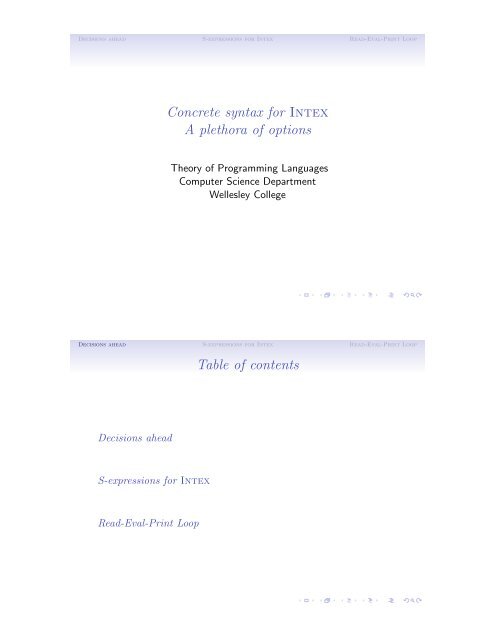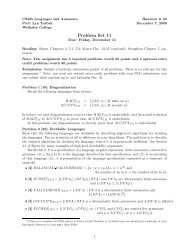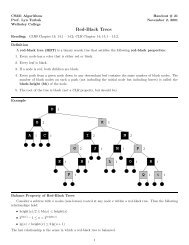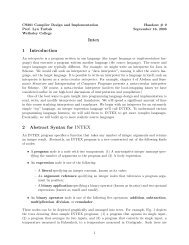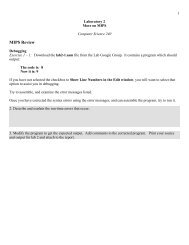Creating a read-eval-print loop - Computer Science - Wellesley
Creating a read-eval-print loop - Computer Science - Wellesley
Creating a read-eval-print loop - Computer Science - Wellesley
You also want an ePaper? Increase the reach of your titles
YUMPU automatically turns print PDFs into web optimized ePapers that Google loves.
Decisions ahead S-expressions for Intex Read-Eval-Print Loop<br />
Concrete syntax for Intex<br />
A plethora of options<br />
Theory of Programming Languages<br />
<strong>Computer</strong> <strong>Science</strong> Department<br />
<strong>Wellesley</strong> College<br />
Decisions ahead S-expressions for Intex Read-Eval-Print Loop<br />
Decisions ahead<br />
S-expressions for Intex<br />
Read-Eval-Print Loop<br />
Table of contents
Decisions ahead S-expressions for Intex Read-Eval-Print Loop<br />
Choosing a concrete syntax for Intex<br />
To make programs easier to <strong>read</strong> and write, we can develop a<br />
concrete syntax that specifies how program trees can be written as<br />
sequences of characters. There are many design choices to make.<br />
For example, how should argument references be written?<br />
• the bash shell programming language uses $i to denote the<br />
ith argument (1-indexed) to a shell script.<br />
• the LaTeX formatting language uses #i to denote the ith<br />
argument (1-indexed) to a macro.<br />
• The main method in a Java class refers to the ith command<br />
line argument as an index (0-based) of an array argument.<br />
Decisions ahead S-expressions for Intex Read-Eval-Print Loop<br />
How are applications of binary operators written?<br />
Suppose we want to represent the following Intex expression tree:<br />
There are many possible notations. For instance:<br />
• In infix notation, the operator is placed between the operands,<br />
as in 1 + (2 * 3).<br />
• In prefix notation, the operator is placed before the operands.<br />
This is the convention in Lisp dialects, in which the example<br />
would be written (+ 1 (* 2 3)).<br />
• In postfix notation, the operator is placed after the operands,<br />
as in 1 2 3 * + or 2 3 * 1 +. Postfix notation is<br />
unambiguous even without parentheses.
Decisions ahead S-expressions for Intex Read-Eval-Print Loop<br />
How should the top-level program be structured?<br />
We could use C and Java’s approach of using a distinguished main<br />
function to specify the entry point to a program:<br />
int main(int a, int b) {return (a + b) / 2;}<br />
However, this uses named parameters rather than positional parameters.<br />
It would be more in line with Intex to specify only the number<br />
of parameters:<br />
int main(int, int) {return ($1 + $2) / 2;}<br />
In this case the main name, int type annotations, return keyword,<br />
and semi-colon are “noise” in the sense that they don’t have any<br />
meaning in Intex and would be ignored. A syntax that mapped<br />
more straightforwardly onto Intex would omit these:<br />
main(2) {($1 + $2) / 2}<br />
Decisions ahead S-expressions for Intex Read-Eval-Print Loop<br />
For the mathematicians<br />
We could use a notation similar to that used to define mathematical<br />
functions:<br />
avg[2] = div(+($1,$2),2)<br />
Here, the name avg has no semantic import (it would be ignored<br />
by Intex), but it is a helpful comment.
Decisions ahead S-expressions for Intex Read-Eval-Print Loop<br />
An s-expression solution<br />
We can represent the Intex tree in s-expression notation, where<br />
each tree node is explicitly labelled by its type:<br />
(program 2<br />
(binapp div<br />
(binapp add<br />
(arg 1)<br />
(arg 2))<br />
(lit 2)))<br />
Here we have adopted the simple prefix convention from Handout<br />
#21 for representing sum-of-product trees as s-expressions: the<br />
first s-expression in a parenthesized sequence is a token that is the<br />
summand node label and the remaining s-expressions are arbitrary<br />
s-expressions that represent the product components.<br />
Decisions ahead S-expressions for Intex Read-Eval-Print Loop<br />
And the winner is ...<br />
We adopt a concise s-expression notation:<br />
• If we assume that numbers stand for themselves, we can avoid<br />
the explicit lit tag. Thus, we will shorten (lit 2) to 2.<br />
• Since we must be able to distinguish argument references<br />
from integer literals, we cannot similarly shorten (arg 1) to<br />
1. But we can use a shorter tag name, such as $, in which<br />
case (arg 1) becomes ($ 1).<br />
• The only non-leaf node is a binary application, so we can<br />
dispense with the binapp tag without introducing ambiguity.<br />
Using (+, -, *, /, %) in place of names (add, sub, mul, div,<br />
rem) further shortens the notation. For example,<br />
(binapp add ($ 1) ($ 2)) becomes (+ ($ 1) ($ 2)).<br />
• To distinguish Intex program from other programs in other<br />
mini-languages we will study, we replace program by intex.
Decisions ahead S-expressions for Intex Read-Eval-Print Loop<br />
Our example programs using create syntax<br />
The result of applying all of the above tricks on our three sample<br />
Intex programs yields:<br />
(intex 1 (* ($ 1) ($ 1))) ; Squaring program<br />
(intex 2 (/ (+ ($ 1) ($ 2) 2))) ; Averaging program<br />
(intex 1 (/ (* (- ($ 1) 32) 5) 9)) ; Temp convert program<br />
These are significantly shorter that the Ocaml AST notation or<br />
the unoptimized s-expression notation. This is the s-expression<br />
notation that we will adopt for Intex.<br />
Decisions ahead S-expressions for Intex Read-Eval-Print Loop<br />
Unparsing Intex AST into s-expressions<br />
# open Intex;; (* Unparsing functions *)<br />
# let f2c = Pgm(1, BinApp(Div,<br />
BinApp(Mul,<br />
BinApp(Sub,Arg(1),Lit(32)),<br />
Lit(5)),<br />
Lit(9)));;<br />
val f2c : Intex.pgm =<br />
Pgm (1,<br />
BinApp (Div, BinApp<br />
(Mul, BinApp (Sub, Arg 1, Lit 32), Lit 5), Lit 9))<br />
# pgmToSexp f2c;;<br />
- : Sexp.sexp =<br />
Sexp.Seq<br />
[Sexp.Sym "intex"; Sexp.Int 1;<br />
Sexp.Seq<br />
[Sexp.Sym "/";<br />
Sexp.Seq<br />
[Sexp.Sym "*";<br />
Sexp.Seq<br />
[Sexp.Sym "-"; Sexp.Seq [Sexp.Sym "$"; Sexp.Int 1]; Sexp.Int 32];<br />
Sexp.Int 5];<br />
Sexp.Int 9]]<br />
# pgmToString f2c;;<br />
- : string = "(intex 1 (/ (* (- ($ 1) 32) 5) 9))"
Decisions ahead S-expressions for Intex Read-Eval-Print Loop<br />
Unparsing Intex programs to s-expressions<br />
let rec pgmToSexp p =<br />
and expToSexp e =<br />
and primopToString p =<br />
match p with<br />
Add -> "+"<br />
| Sub -> "-"<br />
| Mul -> "*"<br />
| Div -> "/"<br />
| Rem -> "%"<br />
and expToString s = sexpToString (expToSexp s)<br />
and pgmToString s = sexpToString (pgmToSexp s)<br />
Decisions ahead S-expressions for Intex Read-Eval-Print Loop<br />
Parsing s-expressions into Intex AST<br />
# open Intex;; (* Parsing functions are in Intex module *)<br />
# let f2cSexp = Sexp.stringToSexp "(intex 1 (/ (* (- ($ 1) 32) 5) 9))";;<br />
val f2cSexp : Sexp.sexp =<br />
Sexp.Seq<br />
[Sexp.Sym "intex"; Sexp.Int 1;<br />
Sexp.Seq<br />
[Sexp.Sym "/";<br />
Sexp.Seq<br />
[Sexp.Sym "*";<br />
Sexp.Seq<br />
[Sexp.Sym "-"; Sexp.Seq [Sexp.Sym "$"; Sexp.Int 1]; Sexp.Int 32];<br />
Sexp.Int 5];<br />
Sexp.Int 9]]<br />
# sexpToPgm f2cSexp;;<br />
- : Intex.pgm =<br />
Pgm (1,<br />
BinApp (Div, BinApp (Mul, BinApp (Sub, Arg 1, Lit 32), Lit 5), Lit 9))<br />
# stringToPgm "(intex 1 (/ (* (- ($ 1) 32) 5) 9))";;<br />
- : Intex.pgm =<br />
Pgm (1, BinApp (Div, BinApp (Mul, BinApp (Sub, Arg 1, Lit 32), Lit 5), Lit 9))
Decisions ahead S-expressions for Intex Read-Eval-Print Loop<br />
Parsing s-expressions into Intex programs<br />
let rec sexpToPgm sexp =<br />
and sexpToExp sexp =<br />
and stringToPrimop s =<br />
match s with<br />
"+" -> Add<br />
| "-" -> Sub<br />
| "*" -> Mul<br />
| "/" -> Div<br />
| "%" -> Rem<br />
| _ -> raise (SyntaxError ("invalid Intex primop: " ^ s))<br />
and stringToExp s = sexpToExp (stringToSexp s)<br />
and stringToPgm s = sexpToPgm (stringToSexp s)<br />
Decisions ahead S-expressions for Intex Read-Eval-Print Loop<br />
<strong>Creating</strong> a <strong>read</strong>-<strong>eval</strong>-<strong>print</strong> <strong>loop</strong><br />
We now have all the pieces to create an interactive <strong>read</strong>-<strong>eval</strong>-<strong>print</strong><br />
<strong>loop</strong> (REPL) similar to those used in an Ocaml interpreter, a<br />
Scheme interpreter, or a bash shell. At its core, the Intex<br />
REPL:<br />
1. Reads an Intex expression the user types at a prompt;<br />
2. Evaluates the Intex expression;<br />
3. Prints the resulting integer value.<br />
For example:<br />
# repl();;<br />
intex> (+ 1 2)<br />
3<br />
intex> (* (+ 3 4) (- 5 6))<br />
-7
Decisions ahead S-expressions for Intex Read-Eval-Print Loop<br />
let repl () =<br />
<strong>Creating</strong> a <strong>read</strong>-<strong>eval</strong>-<strong>print</strong> <strong>loop</strong><br />
let rec <strong>print</strong>ln = StringUtils.<strong>print</strong>ln<br />
and <strong>print</strong> = StringUtils.<strong>print</strong><br />
and sexpToint sexp = (* sexpToint : sexp -> int *)<br />
match sexp with<br />
Sexp.Int(i) -> i<br />
| _ -> raise (Failure ("Not an int!: " ^ (Sexp.sexpToString sexp)))<br />
and getPgm sexp = (* get an intex program from a specification *)<br />
match sexp with<br />
(* Treat a symbol or string as name of a file containing program *)<br />
Sexp.Sym filename -> stringToPgm (File.fileToString filename)<br />
| Sexp.Str filename -> stringToPgm (File.fileToString filename)<br />
| _ -> sexpToPgm sexp<br />
Decisions ahead S-expressions for Intex Read-Eval-Print Loop<br />
<strong>Creating</strong> a <strong>read</strong>-<strong>eval</strong>-<strong>print</strong> <strong>loop</strong><br />
and <strong>loop</strong> args =<br />
let _ = <strong>print</strong> "\\nintex> " in<br />
let line = <strong>read</strong>_line () in<br />
match (Sexp.stringToSexp line) with<br />
Sexp.Seq [Sexp.Sym "#quit"] -> <strong>print</strong>ln "\\nMoriturus te saluto!"<br />
| Sexp.Seq ((Sexp.Sym "#args") :: intxs) -> <strong>loop</strong> (List.map sexpToint intxs)<br />
| Sexp.Seq ((Sexp.Sym "#run") :: pgmx :: intxs) -><br />
let _ = try<br />
<strong>print</strong>ln (string_of_int (run (getPgm pgmx)<br />
(List.map sexpToint intxs)))<br />
with<br />
EvalError s -> <strong>print</strong>ln ("Error: " ^ s)<br />
| SyntaxError s -> <strong>print</strong>ln ("Error: " ^ s)<br />
| Sys_error s -> <strong>print</strong>ln ("Error: " ^ s)<br />
| Failure s -> <strong>print</strong>ln ("Error: " ^ s)<br />
in <strong>loop</strong> args<br />
| _ -> let _ = try<br />
<strong>print</strong>ln (string_of_int (<strong>eval</strong> (stringToExp line) args))<br />
with<br />
EvalError s -> <strong>print</strong>ln ("Error: " ^ s)<br />
| SyntaxError s -> <strong>print</strong>ln ("Error: " ^ s)<br />
| Sys_error s -> <strong>print</strong>ln ("Error: " ^ s)<br />
| Failure s -> <strong>print</strong>ln ("Error: " ^ s)<br />
in <strong>loop</strong> args<br />
in <strong>loop</strong> []
Decisions ahead S-expressions for Intex Read-Eval-Print Loop<br />
Exception handlers<br />
The try . . . with construct specifies an exception handler similer<br />
to Java’s catch. In this case, it catches errors without leaving the<br />
REPL:<br />
intex> (/ 5 0)<br />
Error: Division by 0: 5<br />
intex> (% 7 (- 3 3))<br />
Error: Remainder by 0: 7<br />
intex> (+ 2)<br />
Error: invalid Intex expression: (+ 2)<br />
intex> (+ 2 3 4)<br />
Error: invalid Intex expression: (+ 2 3 4)<br />
Decisions ahead S-expressions for Intex Read-Eval-Print Loop<br />
Specifying argument lists<br />
We have seen how the REPL <strong>eval</strong>uates literals and binary applications.<br />
But how can argument lists be specified? The #args directive<br />
introduces an argument list that can be used to <strong>eval</strong>uate the following<br />
expressions:<br />
intex> (#args 10 20 30)<br />
intex> (+ ($ 1) (* ($ 2) ($ 3)))<br />
610<br />
intex> (#args 5 2 7)<br />
intex> (+ ($ 1) (* ($ 2) ($ 3)))<br />
19<br />
intex> ($ 4)<br />
Error: Illegal arg index: 4
Decisions ahead S-expressions for Intex Read-Eval-Print Loop<br />
Using the #run directive<br />
The #run directive takes an Intex program specification and a<br />
sequence of integer arguments and runs the program on the arguments.<br />
intex> (#run "avg.itx" 3 7)<br />
5<br />
intex> (#run (intex 2 (/ (+ ($ 1) ($ 2)) 2)) 3 7)<br />
5<br />
intex> (#run f2c.itx 212)<br />
100<br />
intex> (#run f2c 212)<br />
Error: f2c: No such file or directory<br />
intex> (#run f2c.itx 212 73)<br />
Error: Program expected 1 arguments but got 2<br />
Decisions ahead S-expressions for Intex Read-Eval-Print Loop<br />
Knowing when to #quit<br />
Finally, we need a way to exit the interpreter. The #quit directive<br />
does this:<br />
intex> (#quit)<br />
Moriturus te saluto!<br />
- : unit = ()<br />
# (* Now we’re back in the OCaml interpreter *)


